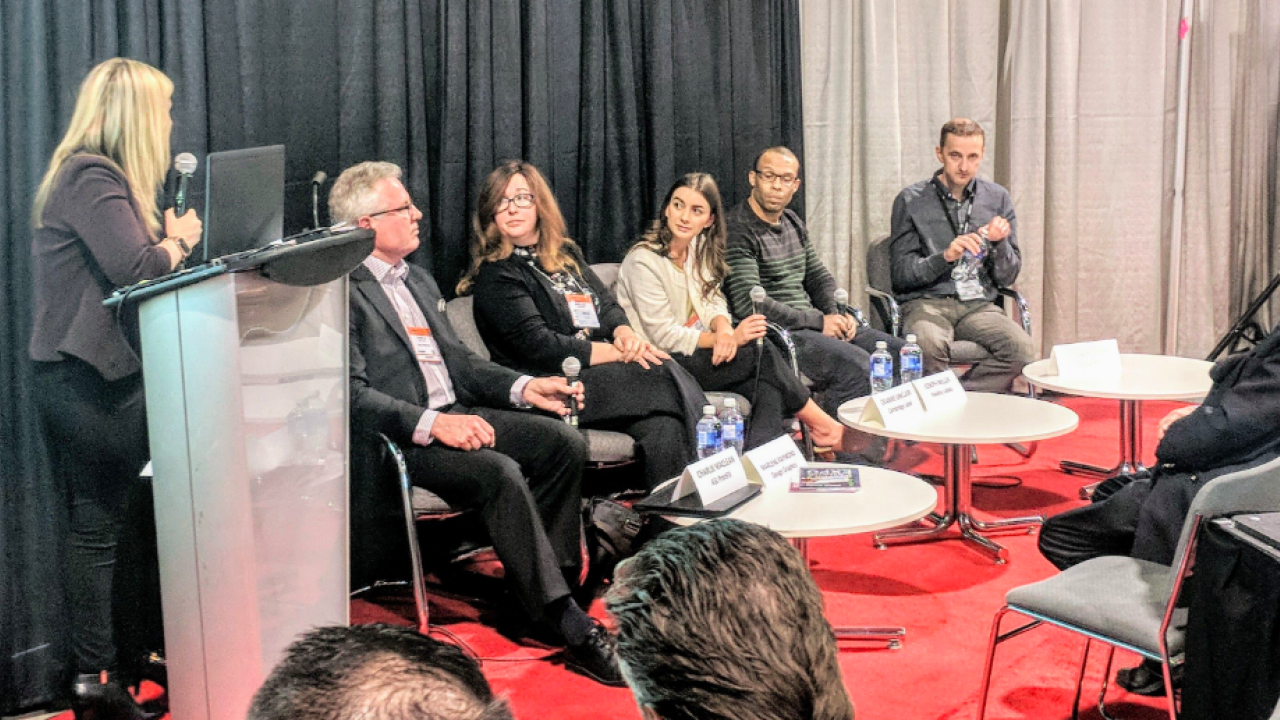Canadian converters tackle tough issues

One stop shop?
The first question tackled by the panel was whether they are diversifying out of pressure-sensitive labels.
ASL PrintFX’s bigger customers are increasingly looking for partners who will go further than just print, said president and CEO Charlie MacLean. ‘They are asking: “What innovations do you have to make us unique?” Value adding is critical.’
On the other hand, MacLean is not sure a one-stop shop is the best strategy. ‘We can’t buy all that technology. Am I going to be focused on where I can make a difference – or an average player offering more?’
Shem Szot from Sticker You agreed: ‘We can simplify our customers’ purchase experience by recommending partners.’
Cambridge Label is a trade-only converter and works closely with print brokers. ‘They are telling us now we have to get into shrink sleeves,’ said managing director Deanne Sinclair. ‘It seems simple as you don’t have to die-cut, but it is actually very challenging – getting the right ink adhesion and ink shrinking at the proper rate. We have been outsourcing finishing and we will get that in-house next so we can also control the seaming.’
Joseph Miller at Kwality Labels is also looking at shrink sleeves. ‘When we bought pre-press in this was a big consideration.’
What about flexible packaging?
Marlene Raymond at Design Graphics said her company had already made the move. ‘A series of our clients are in fruit and vegetables so need unsupported flexpack film and more recently pouches, and this seems to be our biggest area of growth at the moment. That market will grow.’
Szot agreed that it is his fresh food packaging customers who are asking for unsupported film.
Cambridge Label was approached by a co-packer asking if they could print on flexible packaging. ‘It’s a good market for growth but it is a whole other ball game,’ said Sinclair. ‘A major issue is the inflexibility of the materials supply chain. A minimum order is 30 business days delivery and 60,000 ft when I only need 5,000 ft.’
Miller asked: ‘What can we do that makes sense with narrow web equipment and where can we offer value? This is the big value proposition we’ve been working our way through last year.’
Automation
Industry 4.0 and automation are industry buzz-words, but what is the reality on the ground? For Miller the automation conversation has to start with standardization. ‘We are aiming to close the loop between pre-press and process control to make sure that what we proof is what we deliver.’
This directly impacts Kwality Labels’ training program. ‘How can I take as much variability out of the process and then train individuals to a place where they can use their skills? In 10 years’ time, two thirds of my printers will have retired so I have to make sure I am not prioritizing what will be obsolete in three years. So I prioritize learning.’
‘For me automation is the most important thing,’ chimed in Szot. ‘I am pushing data to the cloud and doing this as much as I think about printing. The auto industry has adopted Six Sigma to make sure things are produced effectively and this will come to us. But these things are complicated and the skills gap is massive. You need a bachelor of engineering degree to automate. So, there are opportunities and challenges for the tech we are building.’
Cambridge Label’s Sinclair also makes the link between automation and skills. ‘We installed a new flexo press nine months ago and it is leaps and bounds ahead of machines five to 10 years old. Setting impression is now done by an iPad and you can measure and learn those settings, so automation makes training staff easier.’
Digital
All panelists agreed on the growing importance of digital printing, although MacLean brought up the issue of long-term ROI. ‘Now we have to worry about obsolescence. The timescale is not 10-15 years any more, but six to seven years and what is the return on that asset over that time? But of course, digital is coming and we need to be playing, particularly as the speed of digital inkjet is increasing.’
Cambridge Labels installed its first digital press in 2013 and it was ‘scary to jump in’, recalls Sinclair. ‘I was thinking I could convert a certain number of jobs to digital and now 50 percent of our work is printed digitally. A lot of our customers don’t want to inventory any more, and that helps digital growth.’
For Miller it was the growth of long-run flexo work that drove digital adoption at Kwality Labels. ‘It means we have the right tool for the right job. What digital is doing is freeing up our flexo asset for flexo work. And now we have adopted expanded gamut we can match a color space whether digital or conventional.’
Influencing design decisions
The Q&A session raised the issue of how early the panelists get to see label designs, and whether they have any influence at the design stage.
MacLean said that in the wine and spirits sector the printer is traditionally the last in line. ‘The worst thing is when you’re working at designing the label on the press.’ ASL PrintFX now offers a fast turnaround prototyping service. ‘We don’t do this at the conceptual stage. We try to get to a visual representation of a 90 percent print ready label and that allows you to become an added-value player.’
With a background in graphics, Raymond can tell at an early stage when a job is going to be problematic, ‘and you know that you are going to be fighting through prepress. I work with the client as early as possible to guide them.’
As a trade printer, Cambridge Labels only ever gets sent the print-ready files. ‘If I try to make it better that meets with a lot of resistance,’ said Sinclair.
Miller approaches the issue from a communications perspective. ‘If we communicate using agreed words, the images attached to those words will be delivered as discussed. We are aligning our work standards around FIRST and ISO for flexo and if the print buyer is in that process too we can deliver our capabilities well up stream. We can help designers design with that end in mind.’
Aging workforce
Wherever L&L runs panel sessions across the world, the issue of attracting a younger workforce comes up, and this was no exception.
Szot comes at the problem from an interesting perspective. ‘I have a background in operational systems where you engineer your processes to be consistent with the software you are using. This really reduces the need for training and enables us to bring people to our print shop that do not know the traditional skills.’
Miller at Kwality Labels stresses the importance of a clear career progression. ‘Is there a pathway to contribute to the plant so that every year there is a different focus? I have to know that I won’t spend 12 years on the mounting table.’
Voice of experience
A final thought-provoking audience question asked the panelists what they would do differently if they could start again.
Charlie MacLean said he would definitely have brought in an advisory board. ‘There is a lot of experience out there, not just inside our industry, but financial and legal. So, to have some sage advice from people who have been there and gone through it – trusted advisers who can help you avoid the obvious crazy mistakes. We tend to rely on our insular skillsets but think about meeting with these two to three people once a month – buy them some dinner and go through your experiences.’
Stay up to date
Subscribe to the free Label News newsletter and receive the latest content every week. We'll never share your email address.


